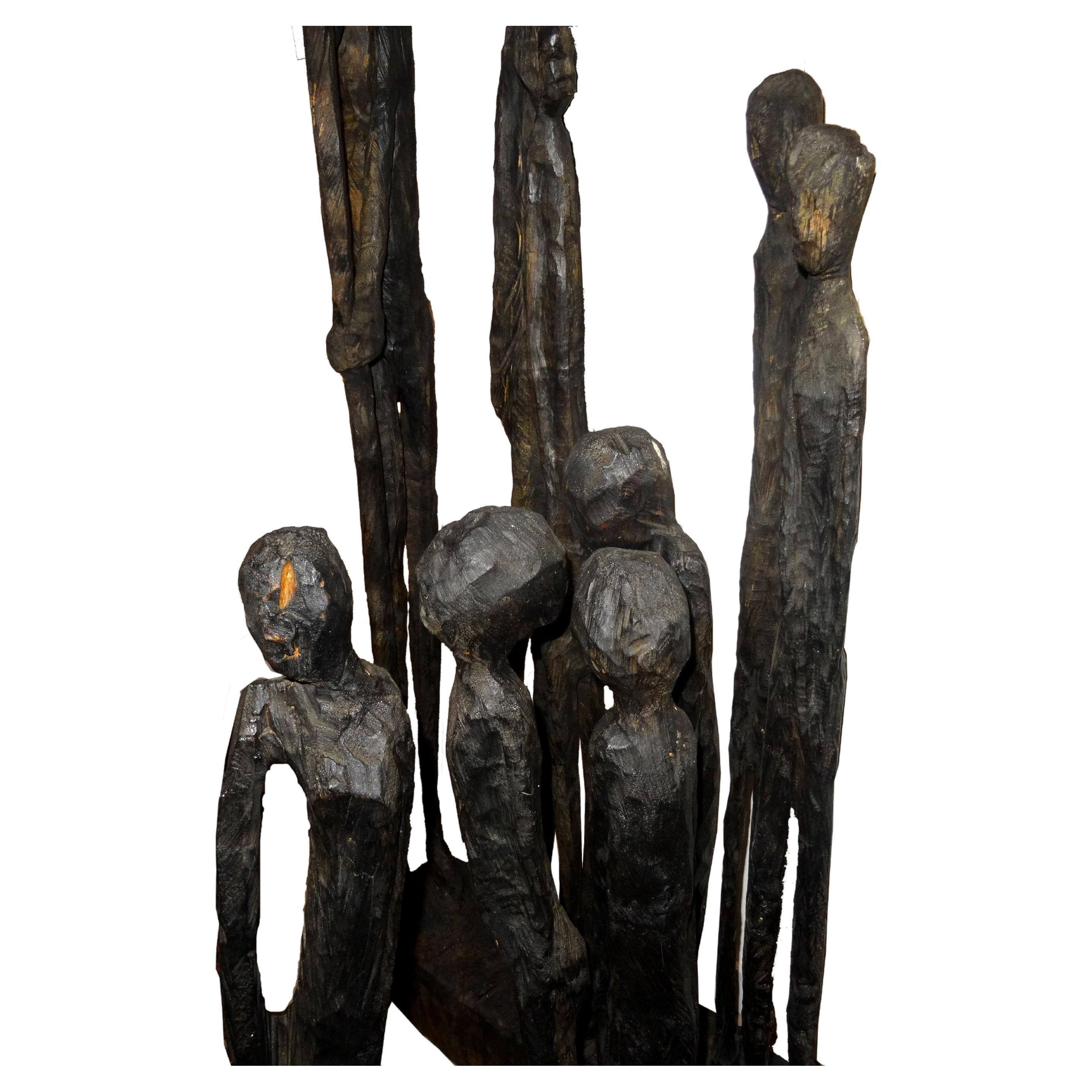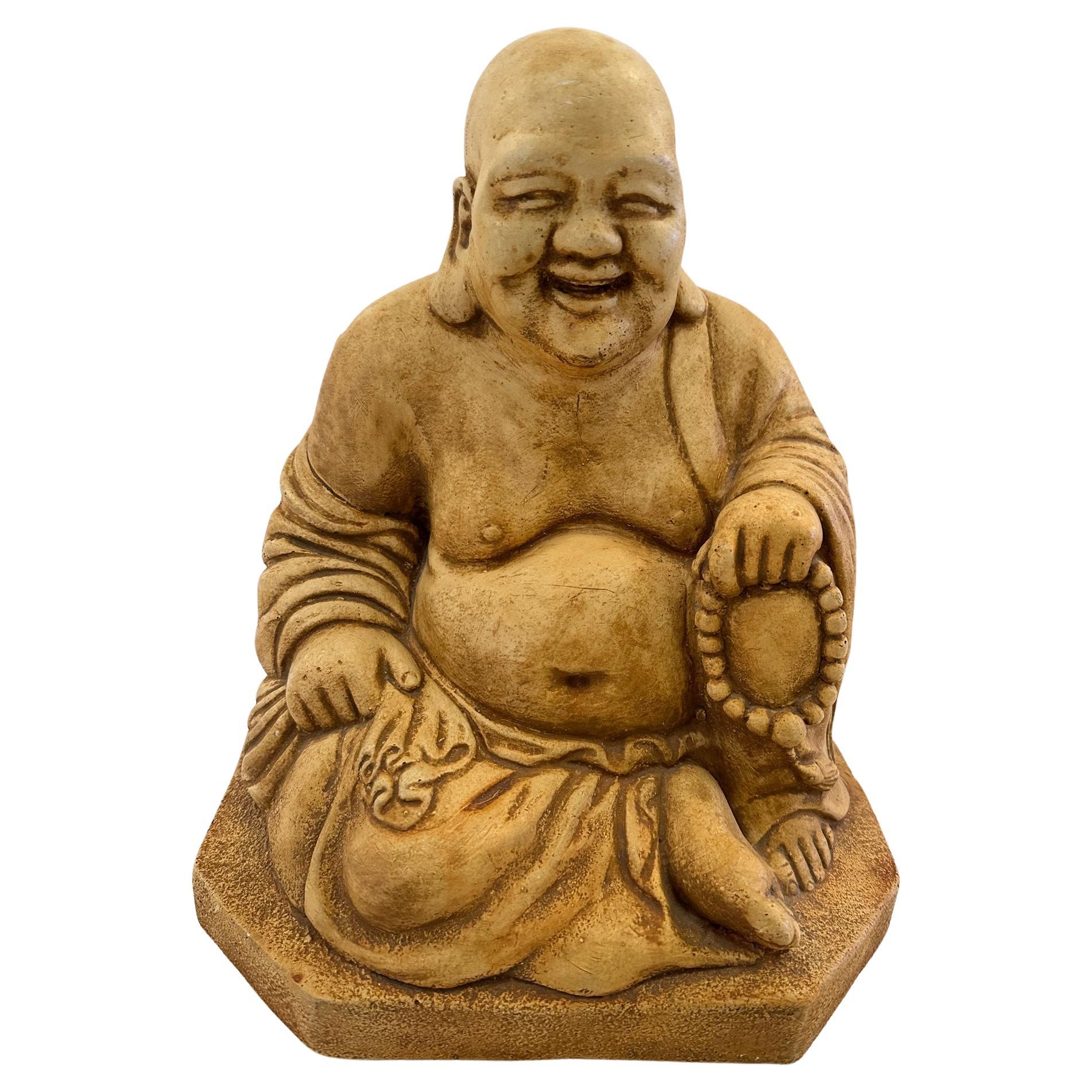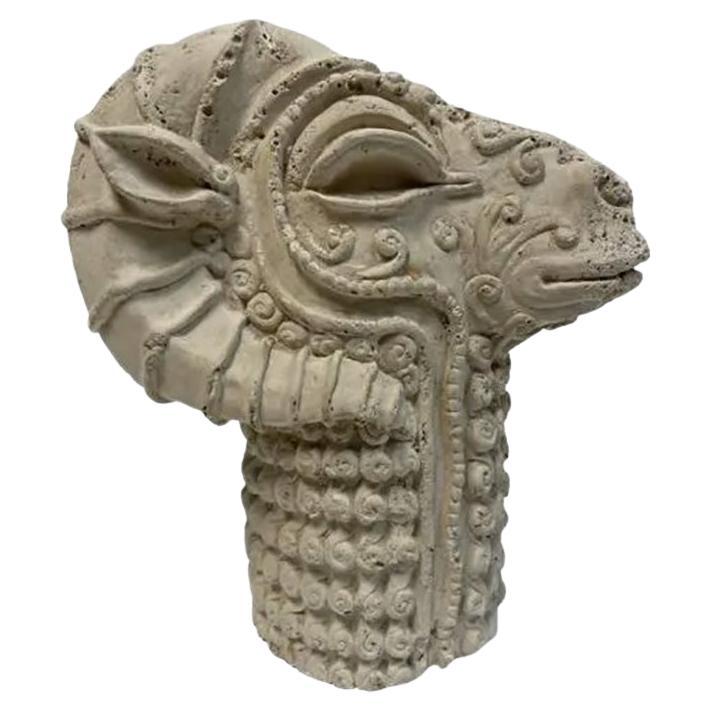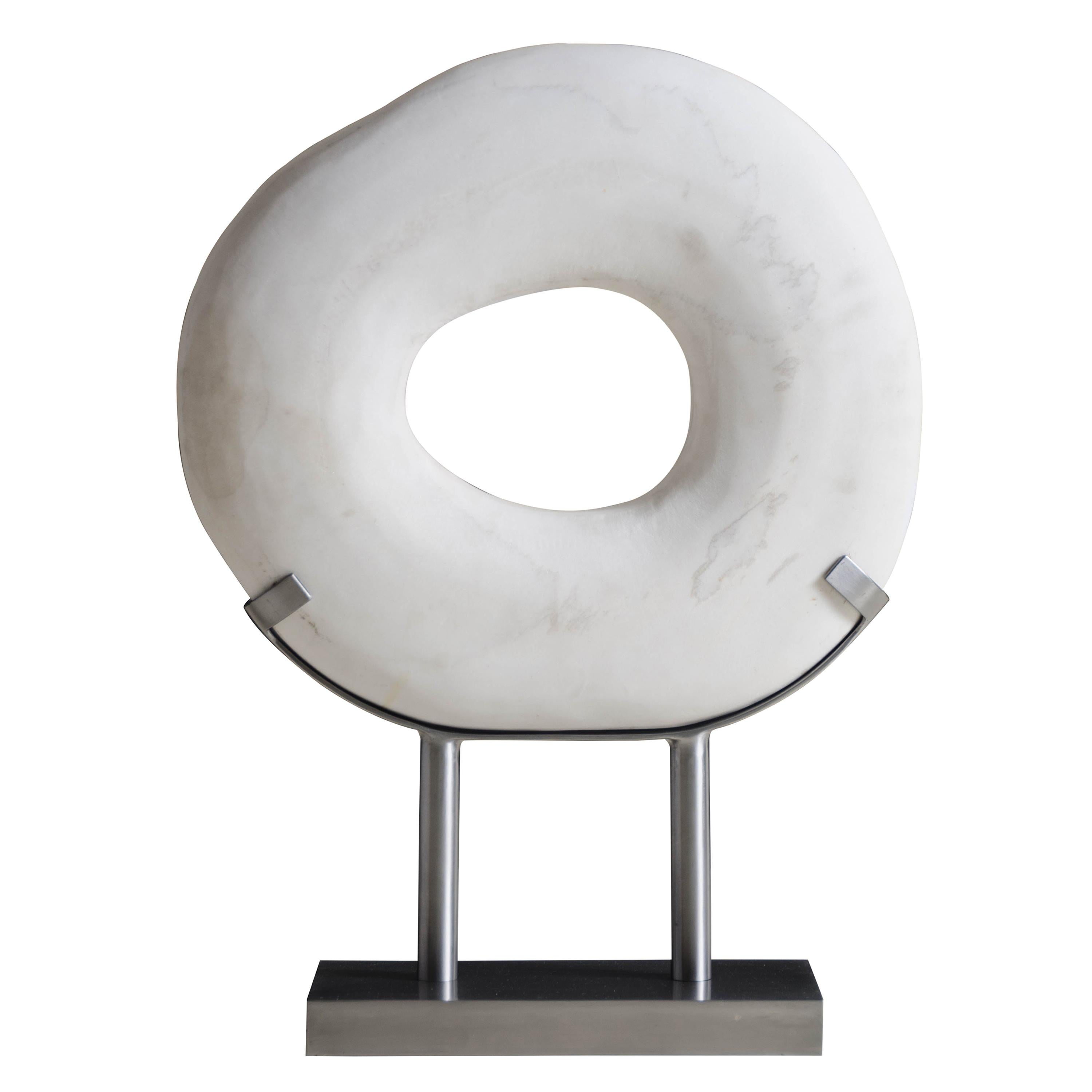Items Similar to Robert Bielat Sculpture Cast Bi-Metal Stone Wood "TRUE EAST"
Want more images or videos?
Request additional images or videos from the seller
1 of 11
Robert Bielat Sculpture Cast Bi-Metal Stone Wood "TRUE EAST"
About the Item
SALE ONE WEEK ONLY
"Robert Bielat was an artist’s artist, a sobriquet applied to those whose work is brilliant but idiosyncratic, deeply compelling in a way that is obvious to those who can see it, but not necessarily so to the market or to the arbiters of so-called “good” taste.
A Bielat exhibition typically overflowed with work, a reflection of his seemingly boundless creativity and, in no small measure, an acknowledgment of his perceived need to get as many of his ideas out into the world as possible in the brief time he had to be a sentient part of it. (Bielat’s work truly embodies the adage: “Ars longa; vita brevis.”) Be that as it may, there are certain themes running through his oeuvre worth remarking upon.
The most obvious and central is the Romantic notion of the will-to-art, a self-determined, intuitive, and autopoetic approach to creative production whereby Bielat absorbed his experience of the world around him and reprocessed it into an expressive vision that was uniquely his own. Bielat possessed an advanced degree in art, but his work seemed to be completely sui generis, as if appearing out of nowhere fully formed, a result of its own conditions of being, and as if it had always been there.
This brings up the notion of time in Bielat’s work, specifically, the phenomenological concept of “sedimentation”—that the past is embedded in the present and that the present is ground from which the future emerges—which is both physically and metaphorically manifest in the work. This is evident in Bielat’s use of the castoff in many works over the years.
Bielat’s re-adoption of bronze manifests another important element in his work, namely, its materiality. Bielat always asserted the primacy of the thing in his production, whether it be the collection of objects, old and new, that he integrated into sculptures or the metals he used in casting. His approach to ceramics, as well, reflected an engagement with the material limits of the medium—severely distressing the clay, slathering on the glaze, leaving sections of bisqueware visible.
The multifaceted ways in which Bielat worked his materials suggests one last aspect of his aesthetic: his concern for craft. Bielat completed his undergraduate studies at what is now College for Creative Studies when it was the School of the Detroit Society of Arts and Crafts, whose “maker” aesthetic has maintained its influence throughout his work. There was always a certain way that Bielat approached his work, not just in his concern for materials, but in how he insisted on maintaining the visibility of the steps taken in its making. Bielat always worked directly, eschewing preparatory sketches or studies. He maintained an iterative dialog with his work, responding as much to its internal dictates—making adjustments along the way—as exercising control over its development.
The philosopher Maurice Merleau-Ponty once wrote the following, which resonates in considering Bielat:
“What one too deliberately seeks, one does not find; and he who on the contrary has in his meditative life known how to tap its spontaneous source never lacks for ideas and value.”
Robert Bielat lived that principle, as an artist and as a human being. The work is his testament."
-Vince Carducci, June 2019
Robert Bilat explains his method via the following:
Bi-metal casting is a process I have been refining throughout my career. The technique of bi-metal casting is the casting of a metal with a low melting point, such as aluminum, around or into a static metal, such as steel, which melts at a higher temperature. Bi-metal casting can be done with bronze or aluminum, combined with a static metal with a higher melting point.
My sculpture constructions are first created with steel and stone affixed into Styrofoam. After the sculpture is completed, it is packed tightly in a foundry box with a 10 percent bentonite and 90 percent sand mixture. The bottom is filled by “ramming”, which is the technique of pounding the bentonite/sand mixture very tightly. The sculpture is placed in the box, and sand is carefully rammed around the sculpture, layered in inches at a time like a parfait. This continues until the sand is level with the top of the box.
After the foundry box is ready, the molten metal is precisely poured from the crucible into the gates, which lead to the Styrofoam portion of the sculpture. The Styrofoam turns into gas and dissipates up through the sand and clay mixture when it is hit by the molten metal. The heat from the molten metal fuses the particles of bentonite with the sand, creating a mold around the sculpture. This is Bi-Metal Casting.
- Dimensions:Height: 12 in (30.48 cm)Width: 6.5 in (16.51 cm)Depth: 12 in (30.48 cm)
- Style:Expressionist (In the Style Of)
- Materials and Techniques:
- Place of Origin:
- Period:
- Date of Manufacture:2000s
- Condition:
- Seller Location:Bloomfield Hills, MI
- Reference Number:1stDibs: LU7781235361252
About the Seller
5.0
Gold Seller
These expertly vetted sellers are highly rated and consistently exceed customer expectations.
1stDibs seller since 2022
11 sales on 1stDibs
Typical response time: 1 hour
- ShippingRetrieving quote...Ships From: Detroit, MI
- Return PolicyA return for this item may be initiated within 14 days of delivery.
More From This SellerView All
- Robert Sestok "Cass Corridor Artist" Detroit Abstract Welded SteelBy Robert SestokLocated in Bloomfield Hills, MIThe "Untitled" abstract sculpture by Robert Sestok has a very deliberate aura of strength in its columnar shape. Upon closer inspection details emerge su...Category
Vintage 1980s American Expressionist Abstract Sculptures
MaterialsSteel
- Edgardo Simone Nude Figurative Sculpture "THE KISS"By Edgardo SimoneLocated in Bloomfield Hills, MISALE ONE WEEK ONLY Edgardo Simone (Italian/American, 1890-1948) The Kiss patinated plaster casting sculpture for kissing nudes fountain sculpture signed to top of base. Classically trained in Italy at the Beaux Arts Academy in Rome from 1906 to 1913, Edgardo Simone became a famous sculptor in Italy and the United States using mediums of terracotta, ceramic, bronze, and plaster. He earned a Doctorate of Design and Sculpture at the Academy and then emigrated to the United States where he worked in New York, Chicago and southern California. His style was influenced by Art Nouveau, Art Deco and other modernist influences. In Italy he had received three times the Croix de Guerre and was decorated by King Victor Emmanuel II and Queen Margherita. Before moving to America, he had much recognition in Italy. He had created war, funeral and city monuments in twenty-six Italian cities. When he arrived in New York City, one of the newspapers carried a headline: "Italy's greatest Sculptor Arrives in New York." In New York, Simone became prominent in society and did many portrait busts including of Thomas Edison, John J. Pershing, Henry Ford and Louis Brandeis...Category
Early 20th Century North American Art Nouveau Figurative Sculptures
MaterialsPlaster
- Tony Rosenthal Abstract Sculpture Blackened Steel Red BlushesBy Tony RosenthalLocated in Bloomfield Hills, MISALE ONE WEEK ONLY UNTITLED is an abstract blackened steel sculpture that has a continuous lively movement. The positioning of the heavy metal is suggestive of dance. There are similarities to the sculptors, Robert Sestok and Tony Smith, who both worked in bronze and painted steel with similar cut out pieces and abstract designs. Untitled has a joyous aura and its small size makes it a charming intimate piece. It might have been a maquette for a much larger piece. The design works in this 14" height as it would in a 14' height. There is a Letter of Certification that will accompany the sculpture. Tony Rosenthal (1914 - 2009) is best known for creating a staggering list of monumental public art sculptures. For over seven decades Tony Rosenthal created an arc of sculpture in a variety of sizes, styles and media, including wood, steel, bronze, brass, cement and aluminum. Every day millions see, enjoy and interact with art created by Rosenthal in cities around the world. In New York City alone, five Rosenthal public art sculptures have been beloved and visible 24/7 for over four decades, yet Rosenthal is not a household name. Art dealer Joseph K. Levene, told The New York Times, Tony Rosenthal "reminds me of a character actor. You know the face but not the name. With him, you know the art." Tony Rosenthal dedicated his life to creating art and actively created sculpture everyday in his Southampton, New York studio until he passed away at the age of 94, July 28, 2009. At nine Rosenthal learned the fundamentals of carving sculpture when his mother, an opera singer enrolled him in children's classes at the Art Institute of Chicago where he learned how to carve sculptures in soap. In 1936 Rosenthal earned a B.F.A. from the University of Michigan, and in 1952 became the first instructor of sculpture at the University of California, Los Angeles. In 1950 Rosenthal was recipient of the San Francisco Museum of Modern Art’s sculpture award; in 1967, Rosenthal received the outstanding achievement award from the University of Michigan and in 1963 a Ford Foundation Grant. After graduating from the University of Michigan, Rosenthal became studio assistant to Alexander Archipenko, the figurative master sculptor, casting bronzes in exchange for sculpture lessons; at night, Rosenthal taught evening classes in drawing and sculpture. In 1939, Rosenthal enrolled at Cranbrook Academy of Art, studying with Carl Milles, Cranbrook's sculptor in residence; there, Rosenthal forged friendships with husband and wife designers Charles Eames and Ray Eames and the sculptor Lilian Swann Saarinen the wife of architect, Eero Saarinen. Decades later Rosenthal acknowledged his gratitude to Cranbrook by donating his archives to them. The Cranbrook Cube, 1984, a 90" painted aluminum cube is in the Cranbrook Museum collection. In 1942, Rosenthal was drafted into the U.S. Army; while stationed in Paris Rosenthal forged friendships with George Braque, Andre Derain, Le Corbusier and Constantin Brancusi, routinely organizing and accompanying groups of soldiers on studio visits. Through multiple visits to Brancusi's Paris studio, Rosenthal learned to create and forge metal sculpture...Category
Late 20th Century American Modern Abstract Sculptures
MaterialsSteel
- Judy Brady Sculpted Ceramic HeadLocated in Bloomfield Hills, MIThe UNTITLED portrait sculpture has a quiet yet powerful and commanding aura. The viewer cannot be around or near it without feeling its presence. It has a very classical approach in...Category
Vintage 1970s American Expressionist Busts
MaterialsPaint, Ceramic
- Monumental Harry Bertoia Silver Necklace, Bertoia Catalogue Raisonne D.JE.49By Harry BertoiaLocated in Bloomfield Hills, MIWEARABLE ART AN IMPORTANT DESIGN FOR A NECKLACE The necklace is unique and extraordinary. Because of its specific design elements it lays beautifully and comfortably on any body structure. This piece comes from a private collection. Provenance will accompany the piece. It has been authenticated by Val Bertoia and is listed in the Harry Bertoia Foundation Catalogue Raisonne # D.JE.49 having been authenticated as a Harry Bertoia piece. REPLY FROM CHRISTIE'S: "Dear Charles, thank you for contacting Christie's. I am absolutely stunned to see the necklace by Harry Bertoia you have submitted for feedback from us, and I would love to speak with you about the work at your earliest convenience. I am a great fan and a known expert in the work of Harry Bertoia, and I have handled over 600 of his sculptures, jewelry and art over the last 22 years. I have never seen a better piece of his jewelry, and it stands as one of the greatest objects in any category that he made. Michael Jefferson Senior Vice President International Senior Specialist Design" The following is from Beverly H. Twitchell, PhD, author of Bertoia: The Metalworker, London: Phaidon, 2019. She provides a very informative critique of Bertoia and his jewelry. Wearable Art an Important Design for a Necklace “Before Harry Bertoia enrolled at the Cranbrook Academy of Art in 1937 he had already mastered traditional jewelers’ techniques, but his engagement with Modernism led him to invent and use more direct methods. Instead of precious metals and gems, Bertoia made jewelry that appealed through its design, craftsmanship and the nature of its materials. That approach would make Bertoia a direct predecessor of the American Studio Crafts movement. So complex and cumulative are human perception and memory that we often do not know from where our own ideas come and without firm evidence, it is impossible to think we can establish the origins of an artist’s ideas. While his jewelry is entirely modern, chokers with multiple small pendants had come from ancient Mediterranean cultures: Mesopotamia, Egypt, Greece and Italy, even from Europe and America at the turn of the last century. Did Bertoia see works in books, journals or at the Detroit Institute of Arts that resonated with him or did he invent this on his own, as he would so many other forms? Bertoia found inspiration in nature from an early age on a small farm in Italy and later in Cranbrook’s woods, on the beaches of southern California and in the fields near his home in eastern Pennsylvania where he lived after 1950. The fluidity and motion of the his jewelry characterize much of his art. In that spirit, too, he made jewelry that suited human anatomy and was animated by its wearer’s movement. Bertoia had the instincts of an engineer, as the intricacy of the present lot’s clasp and overall construction of the jewelry demonstrates. Large jewelry by Bertoia is very rare. A delight to the eye, and like all of Bertoia’s work it is timeless. Bertoia had the instincts of an engineer, as the intricacy of the present lot's clasp and the overall construction of this piece demonstrate. Closed, the necklace sits on a table in a surprisingly conical shape, but it is so flexible that it conforms to its wearer from her neck nearly to her shoulders. Each handmade section is riveted to its neighbors, allowing it to adjust to the body while the pendants curve in many directions: one fits the left clavicle so precisely that Bertoia likely tried it on Brigitta Valentiner, who became his wife in 1943. Other pendants face toward or away from each other, bending up or down. Each element has been hammered into multiple curves and worked in Bertoia’s hands. Large jewelry by Bertoia is very rare. A delight to the eye, this necklace no doubt caused a sensation in its day as it might at the 2022 Met Ball in ours, for like all of Harry Bertoia’s work, it is timeless.” Harry Bertoia (1915 – 1978) was an Italian-born American artist, jewelry creator and modern furniture designer. He was born in San Lorenzo d...Category
Vintage 1940s American Abstract Sculptures
MaterialsSterling Silver
- Hutchenreuther Porcelain Figurine Fritz Klee "OWL"By Professor Fritz KleeLocated in Bloomfield Hills, MIThe 24 carat gilded owl was created by Professor Fritz Klee around 1920 for Hutschenreuther Porcelain. This beautifully crafted piece is unusual in that sur...Category
Vintage 1910s German Animal Sculptures
MaterialsGold
You May Also Like
- Jems Robert Koko Bi - wooden sculptureLocated in Aachen, DESkulptur, Holz, mit Feuer geschwärzt Jems Robert Koko Bi, geboren 1966 in Sinfra an der Elfenbeinküste, kam nach seinem Studium in Abidjan nach Deutschland. Er arbeitete von 1992-19...Category
Early 2000s African Figurative Sculptures
MaterialsWood
- Cast Stone Surrealist Figurative SculptureLocated in Pittsburgh, PACast Stone Surrealist Figurative Sculpture on Marble Base. American, circa mid 20th century.Category
Mid-20th Century American Figurative Sculptures
MaterialsCast Stone, Marble
- Happy Cast Stone Buddha SculptureLocated in Hopewell, NJIrresistible cast stone seated Buddha sculpture having a jolly expression and meticulous detail.Category
Vintage 1970s Figurative Sculptures
MaterialsCast Stone
- Cast Stone Ram's Head SculptureLocated in Scottsdale, AZIntroducing an exceptional piece of art that embodies both uniqueness and timeless design: a one-of-a-kind cast stone Ram's head sculpture. This captivating piece is a true celebrati...Category
Mid-20th Century Animal Sculptures
MaterialsCast Stone
- 1980s Biomorphic Cast Metal SculptureLocated in Pasadena, CAUnusual and dramatic biomorphic cast metal sculpture, circa late 1980s. Sculpture has an organic, tree root like appearance with two curved, root ...Category
Vintage 1980s Abstract Sculptures
MaterialsMetal
- Zong Bi Sculpture in Han Bai Yu Stone on Steel Stand by Robert Kuo, Limited EdBy Robert KuoLocated in Los Angeles, CAZong Bi sculpture on steel stand Han Bai Yu stone Hand carved Limited edition.Category
21st Century and Contemporary Chinese Abstract Sculptures
MaterialsStone
Recently Viewed
View AllMore Ways To Browse
Biomorphic Ceramic Sculpture
Wood Ark
Fantoni Mid Century Modern Sculpture
Andrianna Shamaris Bleached Teak Wood Organic Sphere
Virgin Taxco
Abstract Curvy Ceramics
Nelson Comprehensive
Basque Sculpture
Lime Stone Sculpture
Brutalist English Sculpture
Christian Rolfs
Daum Flame
New And Contemporry Furniture
Stone Paros
Alfredo Arreguin
Carved Raw Edge White Marble Abstract
Truls Melin
Vintage Pixie Figurine





